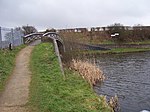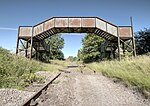Staffordshire Hoard

The Staffordshire Hoard is the largest hoard of Anglo-Saxon gold and silver metalwork yet found. It consists of almost 4,600 items and metal fragments, amounting to a total of 5.1 kg (11 lb) of gold, 1.4 kg (3 lb) of silver and some 3,500 pieces of garnet cloisonné jewellery. It is described by the historian Cat Jarman as "possibly the finest collection of early medieval artefacts ever discovered".The hoard was most likely deposited between 650–675 CE, and contains artefacts probably manufactured during the 6th and 7th centuries. It was discovered in 2009 in a field near the village of Hammerwich, near Lichfield, in Staffordshire, England. The location was in the Anglo-Saxon kingdom of Mercia at the time of the hoard's deposition. The hoard is of "radical" importance in Anglo-Saxon archaeology. The artefacts are nearly all martial in character and contain no objects specific to use by women.: 9 The average quality of the workmanship is extremely high and especially remarkable in view of the large number of individual objects, such as swords and a helmet, from which many of the fragments in the hoard came. The hoard was purchased jointly by the Birmingham Museum and Art Gallery and the Potteries Museum & Art Gallery for GB£3.285 million under the Treasure Act 1996.
Excerpt from the Wikipedia article Staffordshire Hoard (License: CC BY-SA 3.0, Authors, Images).Staffordshire Hoard
Watling Street, Lichfield
Geographical coordinates (GPS) Address Nearby Places Show on map
Geographical coordinates (GPS)
| Latitude | Longitude |
|---|---|
| N 52.655277777778 ° | E -1.9066666666667 ° |
Address
Watling Street
Watling Street
WS8 6LT Lichfield
England, United Kingdom
Open on Google Maps










